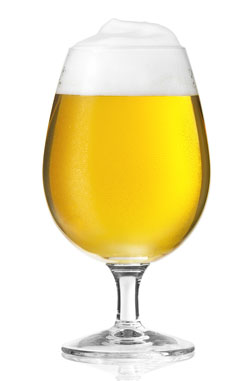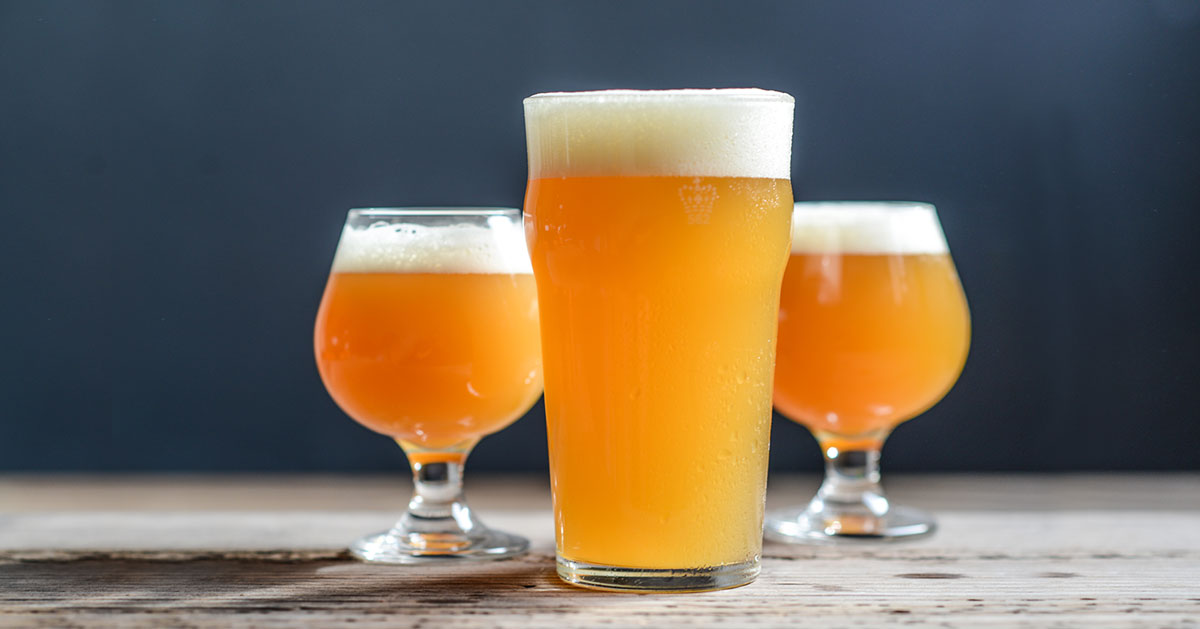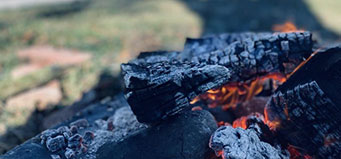The Devil’s Acquaintance: Belgian Golden Strong Ale
 Hello again, and welcome to another edition of Brew Along with Us, Great Fermentations’ recipe of the month blog. This month, we will be focusing on the delicious and beautiful Belgian Golden Strong Ale.
Hello again, and welcome to another edition of Brew Along with Us, Great Fermentations’ recipe of the month blog. This month, we will be focusing on the delicious and beautiful Belgian Golden Strong Ale.
Belgian Golden Strong is a style of beer exemplified by Duvel, a light Belgian golden strong that was really the first of the style, and continues to represent the style so thoroughly that many other beers of the same kind make some reference to the devil in their name (Duvel comes from Duivel, the Dutch word for devil.)
I have traditionally not been a huge fan of brewing Belgian beers, sticking with my more familiar English and American style ales. True, I have a good Belgian Dubbel recipe in my repertoire, and have played around with German lagers, Belgian ales and saisons, but I would rather throw back an imperial pint of a good bitter or IPA before delving into the realm of the fruity and effervescent Belgian ales.
Until I recently read an article by Jon Stange entitled “Belgian Beer: You’re Probably Doing It Wrong.”
His article points out what techniques U.S. brewers employ when making Belgian-style beers, what is wrong with those techniques, and how they can improve. Reading over this article, I got excited to brew a Belgian-style ale, and to try to do it correctly. After throwing some ideas around, I asked a coworker what Belgian-style beer he would brew if he could brew any.
“Duvel” he answered, without hesitation.
Which is what set me down the path to try, with my coworker, to brew an excellent Duvel-style beer: a Belgian Golden Strong Ale.
One of the biggest points that Stange makes in his article is that multi-step mashing is used by Belgian brewers with their less-modified continental malts. So important is this point, and the effects of the rich head and full attenuation that the multi-step mash accounts for, that he reiterates it over again, stating that American-made Belgian-style ales don’t often do true Belgian ales justice with their single-infusion mashes and well-modified malts.
If you have never done multistep mashing, John Palmer does an excellent job of describing, with the mathematics involved, how to do multi-rest mashes with several infusions of hot water in his book How to Brew. If you mash in a kettle on a stovetop or have the ability to direct-fire your mash, (as we plan to do on my coworker’s 10 gallon BrewEasy system) you are probably going to have an easier time of it. If you can’t or don’t want to do a multi-rest mash, I would go with a single infusion rest for a longer period of time at a low temperature, around 146F.
I am including an extract version, but note that you may not be able to get the attenuation or characteristics associated with the style. This is just the nature of extract brewing; you will still be able to make an excellent beer that you can call your own.
Duvel’s recipe uses nothing more than pilsner malt and dextrose, with Styrian Goldings and Saaz hops, and a Belgian golden strong yeast, so that’s what I’m going with. Here we go!
The Devil’s Acquaintance Belgian Golden Strong Recipe (for final volume of 5.5 gallons)
Specs
Estimated O.G. = 1.071
Estimated F.G. = 1.007
Estimated ABV = 8.4%
Estimated bitterness = 35 IBUs
Grain Bill
12 lbs. Belgian Pilsner malt
2.5 lbs. Simplicity (clear) Belgian Candi Syrup, added at the last 15 minutes of the 90 minute boil
Hops
2 oz. Styrian Golding hops (4.5% AA), added with 60 minutes left in the 90 minute boil
1 oz. Saaz hops (3.0% AA), added with 30 minutes left in the 90 minute boil
Yeast
2 to 3 packs (or make an appropriate starter) Wyeast 1388 Belgian Strong Ale yeast or White Labs WLP570 Belgian Golden Ale yeast , or 2 packs Belle Saison dry yeast.
Brewing Process
- The mashing and fermentation schedule of this beer is more complex than most beers. If you cannot follow the schedule exactly, relax, don’t worry, have a homebrew! I’ll try to offer some alternatives to simplify the process.
- Mash-in to reach a beginning mash temperature of 131F (protein rest) & hold for 20 minutes. Ramp or raise the temperature of the mash to 146F (saccharification rest) and hold for 60 minutes. Finally, ramp or raise the temperature to 168F (mash-out) and hold for 15 minutes. Lauter and sparge to collect enough preboil volume to allow for a 90 minute boil. Proceed with the 90 minute boil, adding the Simplicity candi syrup in the last 15 minutes of the boil.
- A Simpler Mash: mash at 146F for 90 minutes. This will allow for a fermentable wort that will still make a great Belgian golden strong. However, the head retention and clarity will not be quite what it would be with a multi-rest mash. Lauter and sparge to collect enough preboil volume to allow for a 90 minute boil. Proceed with the 90 minute boil, adding the Simplicity candi syrup in the last 15 minutes of the boil.
- Chill to 64F, pitch yeast, and allow to raise to 82F over the course of 5 days. If unable to raise this high, raise as high as possible.
- Ferment at 82F for 2 weeks. Then cold crash and lager at 32F for 3 weeks before bottling in Belgian bottles or kegging.
- As I said, this recipe calls for a lot of advanced techniques. If you are unable to follow them exactly, keep calm and brew on! You will still be able to make a fabulous beer by following standard brewing procedures.
Extract Version: Replace 11 lbs of the the pilsner malt with 7 lbs. of light dry malt extract. Steep the remaining 1 lb of Belgian pilsner malt at 150-155F for 30 minutes using a muslin grain bag. Begin with enough volume to allow for a 90 minute boil. Allow the rinsed grain bag to drain for 15 to 20 minutes. Turn off the flame and dissolve the extract thoroughly. Turn the flame back on, bring to a boil and proceed as normal with the 90 minute boil, following the hop schedule and adding the Simplicity candi syrup in the last 15 minutes of the boil. Chill to 64F and follow fermentation schedule as closely as possible.



Hi, is brewing a 5 gallon partial extract of this recipe a matter of just halving the ingredients list?
Can I get the water profile if there was any consideration given to it during brewing? Or at least the city you brewed in so I can track it down.
Thank you
John – Wes here with Great Fermentations. Thank you for your question! When I brewed this, I went for a fairly balanced and light water profile that leaned towards chlorides. I started with RO water and built my salts back, and assumed a very low bicarbonate content. Here were my target ions:
Ca+2: 80
Mg+2: 5
So4 -2: 70
Na+: 10
Cl-: 115
I hope this helps! Cheers, Wes
Thank you wes appreciate the quick response and information. I will follow up with a bew update when i do.
Wes getting ready to brew and I just had one more question, what was the Alkalinity of the water? or the HC03
SPLIT HOPS BREWING COMPANY
John Merlino Owner
johnm@splithopsbrewing.com
CELL: 949-212-0281
2018 via aguila
San Clemente, Ca. 92673
John – Wes again with Great Fermentations. Thank you for your question! I always assume a low HCO3 content of my water as I start with RO and build from there, treating my caculations as if the HCO3 content is very little to almost nonexistant, and try to hit my target pH of about 5.2 in the mash, acidifying with phosphoric acid or raising pH with calcium carbonate added to the mash if need be. In a light beer like this, their may be. There is a good thread on HomeBrewTalk where this is discussed at the following link:
http://www.homebrewtalk.com/showthread.php?t=387390
Look over this and see Martin’s comments on bicarbonate and pairing with acidity in the mash. As he says, it can be one of the most problematic parts of water chemistry for brewers, and is still something I struggle with really getting a good grasp on.
I hope this helps! Let us know if you have any other questions and we will be happy to help you as best we can! Cheers, Wes
So Wes, as the article claims on several threads, controlling bicarbonate is a factor of controlling PH. I use lactic acid and also asorbic acid, my PH in my RO water profile below:
Chloride: 100ppm
Sulfate: 50ppm
Total Alkalinity: 75ppm
CaCo3 Ttl hardness: 80ppm
Calcium Hardness Ca2+: 12ppm
Magnesium Mg+2=12ppm
Sodium+3.375 ppm
usually places me right about at 6.8PH. For my 10.5 gal ttl water bill if I add 1 1/4 tsp. of Asorbic acid to my mash, the ph drops right to 5.3. I still have some other stuff to add but this seems to be in the right direction no?
John – Wes again with Great Fermentations. I used light candi syrup (Simplicy) for mine, as it meshes well with the Belgian Golden Strong Ale style. I hope all goes/went well with the brew! Let us know how it turns out. Cheers! – Wes
Wes I will go one step further than telling you, maybe I will ship you a few bottles of the Belgian Strong Man Ale